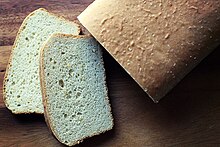 | |
| Alternative names | Salt-risen bread |
|---|---|
| Type | Bread |
| Region or state | Appalachian Mountains |
| Main ingredients | Wheat flour, starter (water or milk; corn, potatoes, or wheat), bacteria (Clostridium perfringens) |
Salt-rising (or salt-risen) bread is a dense white bread that is traditional in the Appalachian Mountains, leavened by naturally occurring wild bacteria rather than by yeast.[1][2][3] Salt-rising bread is made from wheat flour; a starter consisting of either water or milk and corn[4] potatoes,[5] or wheat; and minor ingredients such as salt and sugar.[1] Some common ways of eating salt-rising bread include a slice with sugared coffee poured over it, a grilled cheese sandwich, and the most popular preference, buttered toast.[1]
Salt in the name is a misnomer; the bread is not leavened by salt[4] nor does it taste salty.[6][1] Nutritional analysis reveals only 20 mg per slice.[1] One explanation for the name of the bread is that the use of salt is often added to the starter to inhibit yeast growth and provide an environment more conducive for the bacteria to grow, enhancing the distinct flavors which predominate over the more typical yeast flavors. Another possible origin of the name may be that the starter was kept warm in a bed of heated salt.[4][6][1]
Compared to a sourdough starter, salt-rising bread starter requires a shorter incubation period of 6–16 hours and a higher incubation temperature, of around 40 °C (104 °F).[4][7] Salt-rising bread is denser,[8] with a closer grain than yeast-leavened bread, which results in a flatter top.[7] Due to the unique fermentation, this bread has a distinctive taste and odor.[6][1][2] The pungent odor of the fermenting starter has been described as similar to "very ripe cheese".[4][1]
- ^ a b c d e f g h Bardwell, G., Brown, S. R. (2016) Salt Rising Bread: Recipes and Heartfelt Stories of a Nearly Lost Appalachian Tradition. St. Lynn's Press, Pittsburgh. ISBN 9781943366033.
- ^ a b 4. Juckett, G.; Bardwell, G.; McClane, B.; Brown, S. (2008). "Microbiology of salt rising bread". The West Virginia Medical Journal. 104 (4): 26–7. PMID 18646681.
{{cite journal}}: CS1 maint: numeric names: authors list (link) - ^ Kohman, H.A. (1917). "Salt-rising bread: Raising dough with newly discovered bacteria". Scientific American Supplement. 84 (2179): 212–213. doi:10.1038/scientificamerican10061917-212supp.
- ^ a b c d e Fertig, Judith (2011). Prairie Home Breads: 150 Splendid Recipes from America's Breadbasket. Houghton Mifflin Harcourt. pp. 78–79. ISBN 9781558321731.
- ^ Lundy, Ronni (1994). Shuck Beans, Stack Cakes, and Honest Fried Chicken: The Heart and Soul of Southern Country Kitchens. Atlantic Monthly Press. p. 251. ISBN 9780871136008.
- ^ a b c Clayton, Bernard (2006). Bernard Clayton's New Complete Book of Breads. Simon and Schuster. p. 265. ISBN 9780743287098.
- ^ a b Brown, Susan Ray; Bardwell, Genevieve (2014). "2.2.8 Salt Rising Bread". In Sarkar, Prabir K.; Nout, M. J. Robert (eds.). Handbook of Indigenous Foods Involving Alkaline Fermentation. CRC Press, Taylor and Francis Group (published July 28, 2014). ISBN 9781466565296.
- ^ Kohman, H.A. (6 October 1917). "Salt-rising bread: Raising dough with newly discovered bacteria". Scientific American Supplement. 84 (2179): 212–213. doi:10.1038/scientificamerican10061917-212supp. Retrieved 17 September 2016.